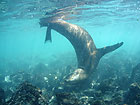

 | |||||||||||||||||
|
|
Journals 2007/2008Beth Jewell
January 10, 2008 I finally met Jon Witman, the scientist I will be working with on the cruise. I woke up at 5 so I took the chance of finding him down at the lab before he took off for the day. He is busy with another project, leaving at dawn and returning at dusk. Before he left he shared his image files with me, asking me to go through them, trying to identify the fish that visited his test sites.
After lunch I met up with Ken and Jenny Collins to go snorkeling. Ken worked at the Darwin Research Station many years ago. He is back trying to catch up with the research being done now so that he can write a grant proposal for some additional research. The water temperature was 21°C, a bit chilly but I survived. The bottom of the lagoon was covered with volcanic rock, not much coral at all. The critters I saw made up for the lack of coral. A sea lion came by to play. He didn't get very close but I could tell he was checking us out. After making our way over to a rock outcrop, I could see marine iguanas sunning themselves. Although there really weren't as many fish as I would like to see the ones I did see were new to me. There was hundreds of bull's-eye puffer fish. Small, no more than six inches long, they were everywhere and not leery of me at all.
I found out this afternoon that I need to have my clothes packed for the cruise on Sunday by 4 tomorrow afternoon. This is so that what I take on the boat can be inspected to make sure I am not taking any plant or animal substances with me that could be introduced to another island. They take the transport of exotic organisms from one island to another very seriously. Most everything I have is dirty and the laundromat is not an easy process. You have to leave your clothes overnight. So I decided I just better wash them by hand. This is going to be a challenge as I need a week's worth of clothes for the boat and 3 days of clothes before we go out. And of course I brought with me only a week's worth of clothes total. Someone is going to be smelly. Jon spent some time explaining his Galápagos research projects to me at dinner. He is interested in benthic ecology and how the physical oceanographic processes, such as upwelling, impacts organisms. Originally, he set out to learn about the diversity found along the underwater ledges (subtidal rock wall habitats) at 6 and 15 meters. His initial research provided him with more questions. He is completing research on what is eating the bottom dwellers, specifically pencil urchins and barnacles, and the trophic cascade that results. With the use of time-lapse photography, he captures predation on film. He uses acetate plates with a safety walk tape adhered to it to study the growth of barnacles. These plates are placed at 6 and 15 meters at several sites in the Galápagos Marine Reserve. The cameras are placed to take pictures of the plates and the organisms coming to feed. While doing these experiments and his long-term ecological monitoring, he noticed a shift in effects on the ecological community between El Niño and La Niña events. During La Niña events, coral bleaching became pervasive from colder water temperatures; however, barnacle recruitment, growth and predation seemed to increase. With the help of two PhD students (Maggy Brandt and Jim Palardy) and an undergraduate student (Laura Dee), he is also looking at predation on sea urchins and coral bleaching. A fourth diver, Franz Smith, will join the divers as well.
|
||||||||||||||||



